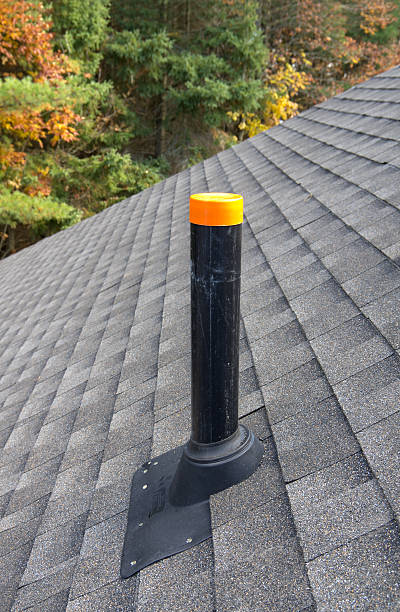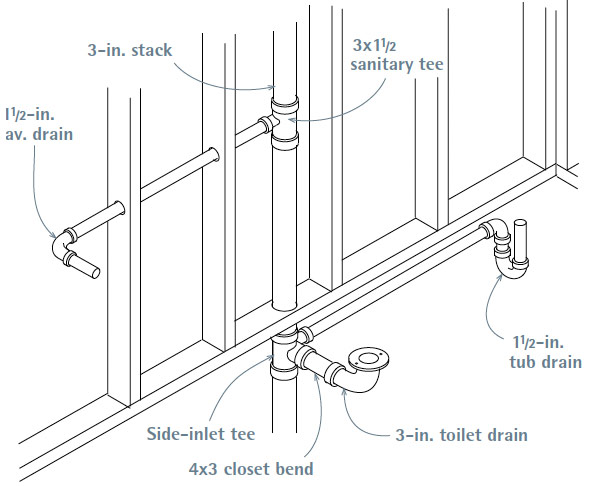Why Proper Ventilation is Essential for Plumbing Systems
Why Proper Ventilation is Essential for Plumbing Systems
Blog Article
We have found this post relating to What Is A Plumbing Vent & How Do They Work? down the page on the internet and figured it made sense to talk about it with you over here.

Proper air flow in pipes systems is commonly neglected, yet it is crucial for preserving the performance and safety of your home's pipes. Ventilation assists control air pressure, prevent the build-up of harmful gases, and ensure the effective elimination of waste. In this guide, we will certainly check out the relevance of appropriate plumbing ventilation, how it works, and the benefits it offers your pipes system.
How Ventilation Works in Plumbing Equipments
Air Pressure Policy
Appropriate ventilation maintains well balanced air pressure within the plumbing system. When water flows through pipelines, it displaces air. Without ample air flow, this displacement can create negative stress, leading to slow drains pipes or siphoning of water from catches, which can cause undesirable odors to permeate into the home.
Avoiding Sewer Gas Accumulation
Among the most vital features of plumbing vents is to stop sewage system gases, such as methane and hydrogen sulfide, from collecting within the home. These gases can posture major health and wellness threats and are extremely combustible. Vent pipes permit these gases to escape securely outside.
Assisting in Waste Removal
Air flow aids in the efficient removal of wastewater by avoiding airlocks in the drain system. When air can stream freely through the vents, it allows water and waste to flow efficiently with the pipes, decreasing the risk of obstructions and backups.
Advantages of Appropriate Ventilation
Improved System Efficiency
Properly aerated pipes systems operate a lot more efficiently, with less blockages, faster draining pipes, and much less pressure on the pipes. This effectiveness prolongs the life-span of the plumbing system.
Improved Air High Quality
By stopping sewage system gases from entering your home, proper ventilation adds to far better interior air top quality, making your living setting healthier and much more comfy.
Protecting Against Water Damages
Appropriate ventilation aids prevent water from being siphoned out of catches, which can lead to sewer gases going into the home and triggering water damages in time.
Steps to Ensure Correct Air Flow
Consulting Pipes Codes
Always consult regional plumbing codes when designing or changing your plumbing system. These codes supply the necessary guidelines for proper airing vent and guarantee your system meets safety and security criteria.
Routine Examination and Upkeep
Routine evaluations can help recognize potential ventilation concerns prior to they become major troubles. Upkeep jobs, such as cleaning up air vent pipelines and looking for blockages, are crucial for keeping the system in good working order.
Professional Installment
For brand-new setups or major modifications, it's wise to work with an expert plumbing. They have the know-how to guarantee the air flow system is appropriately designed and installed according to code.
Comprehending Air Flow in Plumbing
Ventilation in plumbing refers to the network of pipes that permit air to move with the drain system. These vents offer numerous objectives, consisting of managing atmospheric pressure within the pipes, preventing drain gases from getting in the home, and aiding in the smooth circulation of wastewater.
Sorts Of Plumbing Vents
Main Heap Vent
The primary stack vent, additionally known as the air vent stack, is the key vent in a pipes system. It extends from the primary drainpipe line up through the roof, enabling gases to leave and fresh air to get in the system.
Branch Vent
Branch vents link to the primary pile vent and serve specific fixtures, such as sinks, bathrooms, and showers. These vents ensure that each fixture has appropriate ventilation to work correctly.
Air Admittance Shutoff (AAV).
An Air Admittance Valve (AAV) is a one-way shutoff that permits air to enter the plumbing system without the demand for a typical air vent pipeline prolonging via the roof covering. AAVs are typically utilized in renovations or areas where mounting a common air vent is impractical.
Indicators of Poor Ventilation in Pipes.
Slow Draining Fixtures.
If your sinks, tubs, or commodes are draining slowly, it could be a sign of poor air flow. Inadequate air circulation can create a vacuum effect, making it tough for water to drain correctly.
Gurgling Sounds.
Gurgling audios coming from drains pipes are frequently a result of air being sucked via water catches as a result of unfavorable pressure in the pipelines. This is a clear sign of not enough ventilation.
Undesirable Odors.
Drain smells inside your home are a warning that your pipes system is not effectively ventilated. This could indicate that sewage system gases are not being effectively vented outside, resulting in potentially harmful problems.
Common Air Flow Mistakes.
Insufficient Vent Sizing.
Making use of small vent pipes can cause poor air flow and pressure imbalances in the system. It's essential to utilize vents that meet the details needs of your pipes system.
Improper Vent Placement.
Positioning vents as well much from the fixtures they serve can decrease their efficiency. Appropriate placement makes sure that air can flow freely and efficiently via the system.
Disregarding Code Demands.
Building ordinance supply particular guidelines for plumbing air flow. Ignoring these codes can lead to a system that falls short to work properly and may result in expensive repair services or health hazards.
Final thought.
Proper ventilation is an important component of any plumbing system, making certain that it functions effectively and securely. By understanding the significance of air flow, acknowledging the indicators of inadequate ventilation, and taking actions to maintain your system, you can protect against expensive problems and protect your home's air top quality.
4 Things You Should Know About Your Plumbing Vents
What Plumbing Vents Are
Also called a vent stack, a plumbing vent is a vertical pipe attached to your drain line that runs through your roof. The plumbing vent pipe, or plumbing air vent, removes gas and odors from your plumbing system and allows fresh air to enter the pipes, helping the water to flow out of the drain pipes.
What Plumbing Vents Do
Plumbing vents have two basic functions. One of which is to allow unpleasant smelling wastewater and sewer gasses to escape your plumbing system instead of entering your home. Plumbing vent pipes are typically located on roofs, away from windows, to ensure the fumes exit the home completely.
The other function of the plumbing vent is to move fresh air into your plumbing system. This helps move water through every plumbing fixture in your house, like toilets and sink drains. Think of the way in which you need to let a little air into the bottle as you pour soda in order to make the drink flow smoothly.
Different Types of Plumbing Vents
True vent: This is the most common vent option. In simplest terms, a true vent is a vertical pipe attached to your drain line that exits through the roof. They often function as the main vent that other fixtures can connect to. Re-vent pipe or auxiliary vent: Attached to the drain line near specific plumbing fixtures, re-vent pipes run up and over to connect to the main vent. Common vent: Two plumbing fixtures installed on opposite sides of a wall are typically tied into the vent stack using something known as a sanitary cross. Wet vent: This venting option operates as a drain pipe and a vent at the same time. Wet vent drainage systems drain water from one fixture while venting the air from another. Although they’ve been used for over 100 years, wet vent systems have only recently been added to the plumbing code in many areas. If you’re planning on installing one in a bathroom remodel, make sure you check your local code prior to construction. Loop vent: For free-standing fixtures like kitchen island sinks, loop vents are ideal. These vent pipes run under the floor, rise from the P-trap, and create a loop inside the cabinet sink. Air admittance valve: An AAV is a one-way mechanical valve typically installed at the site of the plumbing fixture. AAVs allow venting to occur without having to tie into a larger venting system. They’re ideal for venting fixtures where you aren’t able to easily connect to an existing vent system. Common Plumbing Vent Issues
Although vent pipes typically don’t have water flowing through them, they’re still subject to many typical plumbing issues. For example, clogs are one of the most common problems associated with sewer vent pipes. If your vent pipe gets clogged, all of your plumbing fixtures tied into the vent stack will be affected.
A sink with a slow drain that bubbles and gurgles or a strong sewage smell around your toilet are both indicators that your toilet vent pipe is clogged. Because most vent pipes exit through the roof, old leaves, twigs or even a bird’s nest could be clogging the pipe.
Clogs in your vent pipe system cause a buildup of negative pressure, meaning that water won’t be able to flow out of your home very well. It’s similar to putting your finger over the opening of a straw to trap water inside. When you remove your finger, the water is able to flow out of the straw.
If you suspect you have any blockage in your vent, make sure you have a professional come examine the situation. Left unchecked, a blocked air vent can lead to other costly repairs, like leaks and sediment buildup.
Under Pressure
Pipe vents are essential aspects of a home’s plumbing system. Owning a home means learning about all sorts of things you never put much thought into before. But by understanding as much as you can about the important systems of your home, you can keep those budgets intact and those anxiety levels low.
https://www.homeserve.com/en-us/blog/home-improvement/plumbing-vents/

Do you appreciate more info about The Upsides of Proper Ventilation in Plumbing Design? Try leaving a review down the page. We will be happy to know your opinions about this content. In hopes that you come back again in the future. Enjoyed reading our piece of writing? Please share it. Let somebody else discover it. Thank you so much for going through it.
Call Today Report this page